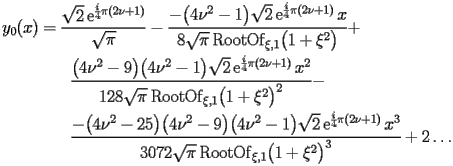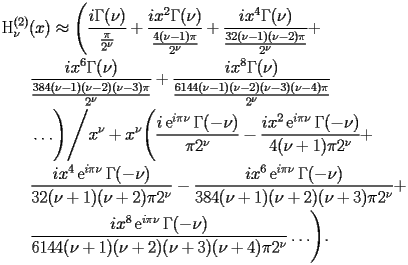H2 Hankel H2
H2.1 Introduction |
top up back next into bottom |
Let
 be a complex variable of
be a complex variable of
 and let
and let
 denote a parameter (independent of
denote a parameter (independent of
 ).The function Hankel H2 (noted
).The function Hankel H2 (noted
 ) is defined by the following second order differential equation
) is defined by the following second order differential equation
| H2.1.1 |
Although
 is a singularity of H2.1.1, the initial conditions can be given by
is a singularity of H2.1.1, the initial conditions can be given by
![\begin{equation*}
\begin{split}
\Bigl[x^{(-\nu)}\Bigr] \operatorname{H} _{\nu} ^{(2)} (x)& =\frac{i \Gamma (\nu)}{\frac{\pi}{2^{\nu}}}, \\
\bigl[x^{\nu}\bigr] \operatorname{H} _{\nu} ^{(2)} (x)& =\frac{i \operatorname{e} ^{i \pi \nu} \Gamma (-\nu)}{\pi 2^{\nu}}.
\end{split}
\end{equation*}](H2_10.gif)
|
H2.1.2 |
The formulae of this document are valid for

H2.2 Series and asymptotic expansions |
top up back next into bottom |
H2.2.1 Asymptotic expansion at
|
top up back next into bottom |
H2.2.1.2 General form |
top up back next into bottom |
H2.2.1.2.1 Auxiliary function

The coefficients
 of
of
 satisfy the following recurrence
satisfy the following recurrence

|

|

|







